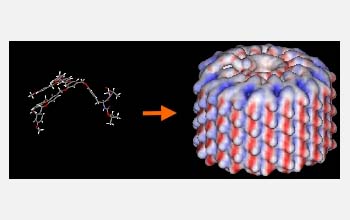News Release 04-101
The Hole Story
University of Pennsylvania chemists create artificial molecular "pores"

The University of Pennsylvania group has discovered a variety of small, protein-like molecules ( ...
August 11, 2004
This material is available primarily for archival purposes. Telephone numbers or other contact information may be out of date; please see current contact information at media contacts.
Researchers at the University of Pennsylvania, supported in part by the National Science Foundation (NSF), have created the first artificial analogs of nature's molecular "pores"--the tiny, hollow channels that perform a multitude of essential tasks in living cells.
Writing in the August 12, 2004, issue of the journal Nature, Penn chemist Virgil Percec and his colleagues note that natural pores are used by the cell to transport certain molecules across the cell membrane, as well as to generate chemical energy, guide the shape of newly-made proteins, and even puncture holes in the cell walls of hostile bacteria. To create the new artificial pores, the authors add, they developed a series of small, protein-like molecules that assemble themselves into molecular channels spontaneously. Potential applications range from the extraction of fresh water from seawater, to an entirely new class of antibiotics.
For details, see the University of Pennsylvania press release.
-NSF-
Media Contacts
M. Mitchell Waldrop, NSF, (703) 292-7752, email: mwaldrop@nsf.gov
Greg Lester, University of Pennsylvania, (215) 573-6604, email: glester@pobox.upenn.edu
Program Contacts
Andrew Lovinger, NSF, (703) 292-4933, email: alovinge@nsf.gov
Principal Investigators
Virgil Percec, University of Pennsylvania, (215) 573-5527, email: percec@sas.upenn.edu
Related Websites
Virgil Percec's research: http://perceco2.chem.upenn.edu/~percec/research.html
The U.S. National Science Foundation propels the nation forward by advancing fundamental research in all fields of science and engineering. NSF supports research and people by providing facilities, instruments and funding to support their ingenuity and sustain the U.S. as a global leader in research and innovation. With a fiscal year 2023 budget of $9.5 billion, NSF funds reach all 50 states through grants to nearly 2,000 colleges, universities and institutions. Each year, NSF receives more than 40,000 competitive proposals and makes about 11,000 new awards. Those awards include support for cooperative research with industry, Arctic and Antarctic research and operations, and U.S. participation in international scientific efforts.
Connect with us online
NSF website: nsf.gov
NSF News: nsf.gov/news
For News Media: nsf.gov/news/newsroom
Statistics: nsf.gov/statistics/
Awards database: nsf.gov/awardsearch/
Follow us on social
Twitter: twitter.com/NSF
Facebook: facebook.com/US.NSF
Instagram: instagram.com/nsfgov


